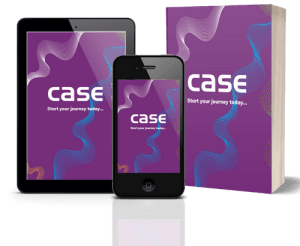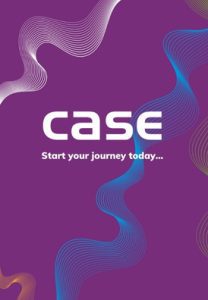Someone from the Duke of Edinburgh Award is coming to present CASE Training Services with a certificate. That’s Olivia’s focus right now. Tomorrow there will be a different reason for her to smile and be happy. CASE will create that I know.
Olivia has been a Learner at CASE for nearly 5 years now and she needs no encouragement to attend. No longer do I have the morning battles of getting her to school (well – the SEN department of a mainstream school, her last year, in particular, was very challenging). I never thought we would get to a point where Olivia was more happy than anxious and stressed. Don’t get me wrong – she still has crisis episodes but they are not as prominent. That’s due to her feeling safe, secure , happy, and settled at CASE.
From the moment she was born, Olivia looked different.
‘Dysmorphic features,’ doctors & paediatricians said. She was a beautiful baby, and she still is beautiful – but dysmorphic is how they described her features. What followed was a path we are still on. A path of being `different`. Olivia presented with global developmental delay (another buzz phrase I heard and saw on her medical notes). She couldn’t walk at two years old and was still shuffling around on her bum. Her talking was delayed and those ‘milestones’ were never met. She became interesting to the medical world; they didn’t know ‘what was wrong with her’.
At three years old, Olivia became a big sister.
Olivia’s baby sister was also ‘different`. Unfortunately, we had to endure cruel comments from paediatricians about the way she looked. If doctors could talk this way about Olivia and her sister, I thought – then what would others say? I made an (upheld) complaint following the comments and was referred to Dr Ashraf – a committed and wonderful doctor. He gave me nuggets of wisdom that I still use today.
He said ‘we can go on and on, testing for syndromes and a diagnosis. Or, we can look at Olivia, this beautiful little doll – and think about what we can do to support her and how we can make interventions to have the best life possible.’
Olivia now has two younger sisters and I follow that mentality every day for the three of them.
There has been many, many appointments and specialists over the years; Olivia had febrile seizures, she had orthopaedic boots to help her walk, operations on her eyes, MRIs, CTs, genetics, an endocrinologist, a neurologist, learning disability nurses, psychologists…. and these sessions have followed her into adulthood. She is at high risk of osteoporosis, has natural calcium & vitamin D deficiency and has central obesity due to her genetic makeup.
I had to battle for support constantly.
Olivia’s nursery labelled her as a nuisance. I battled Olivia’s school for a Statement of Educational Needs (now known as EHCP) plan. Every step of Olivia’s education was a struggle.
But we met angels along the way, too. Olivia’s reception teacher was wonderful and went way over the remit to put in place Olivia’s own curriculum, and the level of acceptance from other children was amazing thanks to her. I still think part of Olivia’s wonderful confidence is due to her reception year at school.
At three years old, Olivia became a big sister.
Olivia’s baby sister was also ‘different`. Unfortunately, we had to endure cruel comments from paediatricians about the way she looked. If doctors could talk this way about Olivia and her sister, I thought – then what would others say? I made an (upheld) complaint following the comments and was referred to Dr Ashraf – a committed and wonderful doctor. He gave me nuggets of wisdom that I still use today.
He said ‘we can go on and on, testing for syndromes and a diagnosis. Or, we can look at Olivia, this beautiful little doll – and think about what we can do to support her and how we can make interventions to have the best life possible.’
Olivia now has two younger sisters and I follow that mentality every day for the three of them.
There has been many, many appointments and specialists over the years; Olivia had febrile seizures, she had orthopaedic boots to help her walk, operations on her eyes, MRIs, CTs, genetics, an endocrinologist, a neurologist, learning disability nurses, psychologists…. and these sessions have followed her into adulthood. She is at high risk of osteoporosis, has natural calcium & vitamin D deficiency and has central obesity due to her genetic makeup.
I had to battle for support constantly.
Olivia’s nursery labelled her as a nuisance. I battled Olivia’s school for a Statement of Educational Needs (now known as EHCP) plan. Every step of Olivia’s education was a struggle.
But we met angels along the way, too. Olivia’s reception teacher was wonderful and went way over the remit to put in place Olivia’s own curriculum, and the level of acceptance from other children was amazing thanks to her. I still think part of Olivia’s wonderful confidence is due to her reception year at school.
Olivia’s complex medical terminologies made my eyes glaze over.
As the years passed, I was asked to participate in a study for children with undiagnosed developmental delay. I agreed as it only required mouth swabs on Olivia and her little sisters. I’d forgotten about it when, two years later, I received a phone call from Leeds Genetics hospital. They had found a ‘mutation on PRMT7 gene’. Olivia and her sisters were three of the six cases that had been identified. So she’s made medical history and there’s a photograph and article in medical publications. Her syndrome has now been given a name; SBIDDS (Short Stature, Brachydactyly, Intellectual Developmental Disability, and Seizures).
So in medical terms, this is Olivia; ‘A rare genetic, multiple congenital anomalies syndrome characterized by short stature, hand brachydactyly with hypoplastic distal phalanges, global development delay, intellectual disability, and more variably seizures, obesity, and craniofacial dysmorphism that includes microcephaly, high forehead, flat face, hypertelorism, deep-set eyes, flat nasal bridge, averted nostrils, long philtrum, thin lip vermilion, and short neck.’
In my terms, Olivia is differently-abled. She’s amazing, she’s funny, she’s kind, she’s caring, and she’s loving. She just needs a bit more help than many. She can’t make a cup of tea safely but she can sing a song that melts hearts.
CASE embraces Olivia for all that she is, and all that she isn’t.
During the pandemic, CASE continued to bring their Learners together with weekly work (fun) packs sent home, along with daily online sessions. That was so important for Olivia and so wonderful to see her in her world, seeing all her friends online. From fitness sessions to crafts & quizzes: CASE continued to give Olivia a reason to be excited for each day.
When Olivia started at CASE, aged 16, I thought her academic level had been reached. She could barely write, she had no IT skills, and very few independent life skills. I was wrong. Her EHCP is in place until she’s 25 years old and CASE somehow manages the perfect balance of progressive learning but also living a fulfilling life. As Olivia says, she ‘lives her best life ‘ there. When she’s 25 she will stay at CASE under Adult Services. She couldn’t be happier about her future and neither can I.
Olivia has many challenges, often complex, but she is fabulous and I wouldn’t change anything about her.
Jo, (very proud mum of Olivia).








